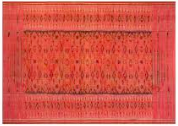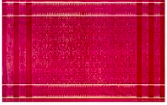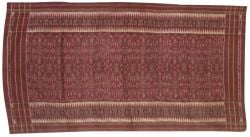Difference between revisions of "Cepuk"
| (9 intermediate revisions by 4 users not shown) | |||
| Line 1: | Line 1: | ||
| + | {{PageSponsorWord}} | ||
{{Balinese Word | {{Balinese Word | ||
| + | |balinese word=c)puk/ | ||
|is root=No | |is root=No | ||
| − | |media= | + | |root=cepuk |
| + | |media=cepuk | ||
| + | |mider=cepuk | ||
| + | |aga=cepuk (Nusa Penida) | ||
| + | |related words=Endek; kain; kamen; kwaca; panganggo | ||
| + | |english translations=a kind of ikat cloth or fabric whose base color is red | ||
| + | |indonesian translations=sejenis kain ikat yang warna dasarnya merah | ||
|definitions={{Balinese Word/Definition Object | |definitions={{Balinese Word/Definition Object | ||
|language=en | |language=en | ||
|definition="Ceremonial protective textile - weft ikat, woven silk or cotton follows resembles the layout of a patola (kain bebali). Wastra, silk with cepuk design - for special ceremonies (kain bebali)." | |definition="Ceremonial protective textile - weft ikat, woven silk or cotton follows resembles the layout of a patola (kain bebali). Wastra, silk with cepuk design - for special ceremonies (kain bebali)." | ||
| + | |part of speech=noun | ||
| + | }}{{Balinese Word/Definition Object | ||
| + | |form=Mider | ||
| + | |language=en | ||
| + | |definition=a kind of ikat cloth or fabric whose base color is red | ||
| + | |part of speech=noun | ||
| + | }}{{Balinese Word/Definition Object | ||
| + | |form=Mider | ||
| + | |language=id | ||
| + | |definition=sejenis kain ikat yang warna dasarnya merah | ||
| + | |part of speech=noun | ||
| + | }}{{Balinese Word/Definition Object | ||
| + | |form=Mider | ||
| + | |language=id | ||
| + | |definition=kain khas dari Nusa Penida | ||
| + | |part of speech=noun | ||
}} | }} | ||
|examples={{Balinese Word/Example | |examples={{Balinese Word/Example | ||
| Line 11: | Line 35: | ||
|en=Cepuk textile, cotton | |en=Cepuk textile, cotton | ||
Nusapenida - size: 81 x 125 cm | Nusapenida - size: 81 x 125 cm | ||
| − | |ref=© | + | |ref=© Textiles and photographs: Karin Sukarya |
}}{{Balinese Word/Example | }}{{Balinese Word/Example | ||
|image=Screen Shot 2018-08-16 at 11.51.23 AM.png | |image=Screen Shot 2018-08-16 at 11.51.23 AM.png | ||
|image ref=Karin Sukarya | |image ref=Karin Sukarya | ||
| − | |ref=© | + | |ref=© Textiles and photographs: Karin Sukarya |
}}{{Balinese Word/Example | }}{{Balinese Word/Example | ||
|en=The textiles shown here were produced in the Palace of Buleleng and some in Jembrana Regency between 1890 and 1920 by noblewomen and were restricted to the nobility. | |en=The textiles shown here were produced in the Palace of Buleleng and some in Jembrana Regency between 1890 and 1920 by noblewomen and were restricted to the nobility. | ||
| Line 21: | Line 45: | ||
|image=Cepuk 70.0 8256 AMNH.jpg | |image=Cepuk 70.0 8256 AMNH.jpg | ||
|en=Cepuk based on Indian double ikat patola prototype cloth. Bali, Indonesia, 1938. Cotton. Cotton; handwoven endek | |en=Cepuk based on Indian double ikat patola prototype cloth. Bali, Indonesia, 1938. Cotton. Cotton; handwoven endek | ||
| − | (weft ikat or tie-dyed, resist patterned) 59 7/ 8 x 32 1⁄4 in. (152 x 82 cm). Courtesy of the Division of Anthropology, American Museum of Natural History, 70.0/8256. Donated by Margaret Mead. | + | (weft ikat or tie-dyed, resist patterned) 59 7/ 8 x 32 1⁄4 in. (152 x 82 cm). Courtesy of the Division of Anthropology, American Museum of Natural History, 70.0/8256. Donated by Margaret Mead. The eight-pointed star pattern is called chhabadi bhat in India and jilamprang in Indonesia. |
|ref=Courtesy of the Division of Anthropology, American Museum of Natural History, 70.0/8256. Donated by Margaret Mead. | |ref=Courtesy of the Division of Anthropology, American Museum of Natural History, 70.0/8256. Donated by Margaret Mead. | ||
| + | }}{{Balinese Word/Example | ||
| + | |image=Cepuk Ngurah Ni-Gede 2017.jpg | ||
| + | |en=Cepuk Bintang Kurung, Ngurah Hendrawan, dyer, and Ni Gede Diari, weaver, Nusa Penida, Bali, Indonesia, 2017. Cotton, natural dyes; handwoven plain-weave endek (weft ikat or tie-dyed, resist patterned), 95 1⁄4 x 30 3⁄4 in. (242 x 78 cm). Used as protection in toothfiling (potong gigi) ceremonies. | ||
| + | |ref=Bard Graduate Center Study Collection. | ||
}} | }} | ||
}} | }} | ||
Latest revision as of 04:50, 11 November 2023
- a kind of ikat cloth or fabric whose base color is red (Mider) en
- "Ceremonial protective textile - weft ikat, woven silk or cotton follows resembles the layout of a patola (kain bebali). Wastra, silk with cepuk design - for special ceremonies (kain bebali)." en
- sejenis kain ikat yang warna dasarnya merah (Mider) id
- kain khas dari Nusa Penida (Mider) id

Cepuk textile, cotton Nusapenida - size: 81 x 125 cm

No translation exists for this example.

Cepuk based on Indian double ikat patola prototype cloth. Bali, Indonesia, 1938. Cotton. Cotton; handwoven endek (weft ikat or tie-dyed, resist patterned) 59 7/ 8 x 32 1⁄4 in. (152 x 82 cm). Courtesy of the Division of Anthropology, American Museum of Natural History, 70.0/8256. Donated by Margaret Mead. The eight-pointed star pattern is called chhabadi bhat in India and jilamprang in Indonesia.

Cepuk Bintang Kurung, Ngurah Hendrawan, dyer, and Ni Gede Diari, weaver, Nusa Penida, Bali, Indonesia, 2017. Cotton, natural dyes; handwoven plain-weave endek (weft ikat or tie-dyed, resist patterned), 95 1⁄4 x 30 3⁄4 in. (242 x 78 cm). Used as protection in toothfiling (potong gigi) ceremonies.
